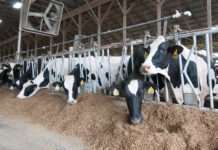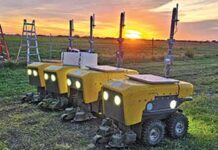Greg Doering, Kansas Farm Bureau
The deer heard my footsteps crunching oak leaves as I crested a hill coming up out of the creek bottom. They didn’t make a sound as they darted through the clearing ahead of me. The white of their tails only briefly signaled their retreat before they slipped further into the tree line.
I was taking advantage of decent temperatures to get one last hike in through the forest. They were fattening up before the real weather arrived. I had intruded on their afternoon of browsing on acorns scattered across the ground.
The deer weren’t the only sign of colder days ahead. Everywhere I looked there were scant few signs of the previous growing season. A few persimmon fruit were still attached to one tree, but the majority of the burnt orange orbs were scattered among the acorns and hickory nuts on the forest floor.
Except for a few maples, whose foliage had turned a deep red warning of what’s to come, the rest of the trees had shed their leaves. The bare branches overlapped like thin fingers against the steel gray sky.
I pushed on, crossing the clearing, sliding down the other side of the hill back to the creek valley. The wind was blowing hard enough to make 65 feel a bit chilly when out in the open. In the protection of the trees and terrain, however, my sweatshirt proved to be almost too warm.
I worked south as I scouted for an easy crossing, finding a gravel bar after a short hike along the bank. The ripples in the crystal-clear water spanned about four feet and appeared to be only a few inches deep. I carefully placed my foot on a mossy rock, and the water rose to just below my ankle. My treated boots kept my feet dry, but those and my wool socks couldn’t keep the cold from creeping in like an unwelcome guest.
After making it across, I continued my push further upstream. I stopped at a pool on the far side of a 10-foot bank. The water was perfectly still, which provided a mirror image of the barren and khaki-colored world around it when viewed from an angle. Stepping to the water’s edge, I could see minnows still flitting about above the bedrock polished by running water.
The opposing bank was a geological time capsule from the tan topsoil with roots protruding to the first sheet of shale, which stair-stepped into the water below. The sedimentary veneer once layered at the bottom of a shallow sea are now being carved away by a seasonal stream.
This is where I decided to end my journey on foot. The valley narrowed up ahead and the tree cover lessened, allowing for more undergrowth. While a recent frost had taken care of the ticks and copperheads, there were still plenty of locust trees and other thorny obstacles ahead.
I retreated to the comfort of a four-wheeler and revved it down an old dirt road, crossing a low-water bridge. The road climbed up a hill before disappearing into pasture. I followed the crest of the hill looking over the creek below, watching as the large hardwoods to the north transitioned to a smattering of redbuds and finally brush along the banks.
Just as the brush was giving way to grassland, I spooked another deer, a single doe, out into the open. I got a better look at her than the others. She appeared to be in good health and looked primed for the season to come. She cleared a fence without any hesitation and, moments later, was gone over the horizon.
I thought it best to end my intrusion here and went to my truck. On the drive home, I couldn’t help but think about how fortunate I was to have the time and cooperative weather to wander through a world waiting for winter to arrive. I’m not quite ready, but it will be here soon.
“Insight” is a weekly column published by Kansas Farm Bureau, the state’s largest farm organization whose mission is to strengthen agriculture and the lives of Kansans through advocacy, education and service.




